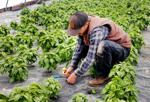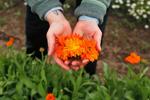Farmer and owner of Purple Sage Farms in Middleton, Idaho, Tim Sommer believes that growing herbs goes hand-in-hand with cooking at home.
Many people across the country have recently started new or expanded their home gardening efforts, planting lettuces, vegetables and herbs for culinary or medicinal uses. Knowing what’s in season assures optimal flavor and freshness.
During growing season, Sommer recommends visiting local farmers’ markets, nurseries or farms to get live plant starts or naturally harvested seeds, both of which often come with growing advice from local experts.

Mike Sommer in the greenhouse in the thick of Purple Sage Farms organic basil.
Getting started
Once potted or in the ground, herbs thrive in well-drained soil, says Mike Sommer, Tim’s son and Purple Sage Farms operations manager. Coarse sand or fine gravel can be helpful additions.
“The herbs don’t need to be pampered,” Mike adds. Some herbs, like coriander, actually gain more flavor when stressed.
Be aware that too much water can lead to fungus growth on the plants, and certain plants may require different watering techniques.
Growing pollinator plants along with herbs will attract local bees while repelling more harmful insects. When choosing flowers to support pollination, Idaho Botanical Garden advises adding plants that bloom at different times throughout the growing season. For example, crocus flowers support the first wave of bumblebees in late winter, while Oregon grape flowers and catmint continue to feed the insects through late spring. Good choices for summer include blanketflower, fernbush and coneflower to feed butterflies; asters and rabbitbrush continue to provide nectar and pollen through the fall months.
Once spring arrives, the Idaho Botanical Garden discourages against removing dried plant stems that may house hibernating bees and raking leaves that can provide helpful compost. Purple Sage Farms utilizes sheep manure for compost that the farm in turn uses to grow Miner’s lettuce and comfrey, which can be made into a compost tea to spray in a garden or onto crops as a fertilizer. Feverfew, lemongrass and mint can act as natural insect repellents.
If you’re interested in growing a variety of your own herbs, Idaho Botanical Garden suggests considering a greenhouse sited in a sunny section of your property. If you’re growing herbs in beds, regular weeding is beneficial.

Calendula is one of the many edible flower varieties grown at Purple Sage Farms.
Harvesting, use and storage
When it comes to harvesting, Purple Sage Farms advises hand-harvesting herbs in their prime at the peak of their nutritional value and flavor when essential oils are the most abundant.
“Herbs love to be harvested, so cut and use them often,” Mike says.
The Sommers advise keeping herbs on the stem when drying them. If you live in a warm, dry geographical area, place herbs on paper towels to dry naturally on a flat counter space out of the sun. It may be tempting to speed up the process in the oven, but Jackie Sommer, Mike’s wife and Purple Sage Farms manager, doesn't recommend it.
“Most ovens do not have a setting to go below 170 degrees, which is way too hot to dry herbs,” she says. “It’s best to dry herbs at 110 degrees or lower to preserve their flavor, nutrients, color and shelf life.”
After drying, herbs may need to be sorted by hand for any unwanted, leftover stems or flowers before use.

Dried calendula petals add vibrancy and a touch of bitterness to any entrée, appetizer or salad. Photo provided by Purple Sage Farms.
Freezing is another preservation option, but not all herbs do well with the process.
“Rosemary would not be a good herb to freeze due to all of the essential oils,” Jackie continues. “Some herbs like basil can be excellent to freeze once processed into foods like pesto. It just needs some lemon juice and a protective barrier like plastic wrap to preserve it the most effectively. We really prefer freshly dried herbs over any other method; nothing else compares in our experience.”
Dried herbs can maintain their quality for up to three years if stored in an airtight jar or container in a cool, dry, dark space out of the sun.
June 21, 2021 at 06:30PM
https://ift.tt/3xz5tSs
Growing, preserving, storing your own herbs - Napa Valley Register
https://ift.tt/3eCf9lu
Herb
No comments:
Post a Comment